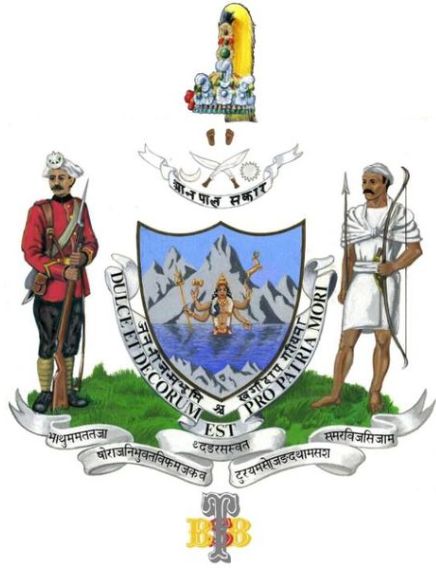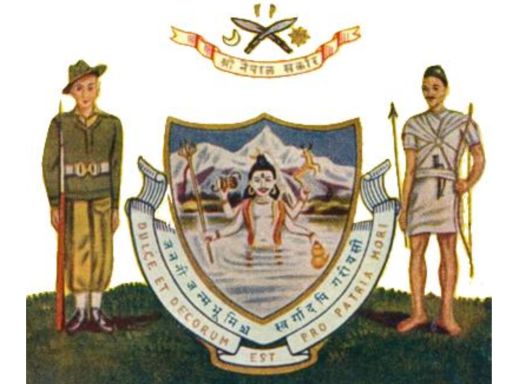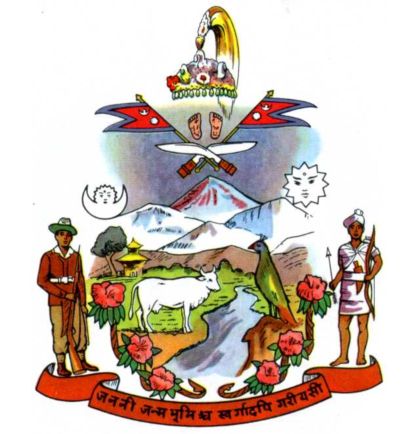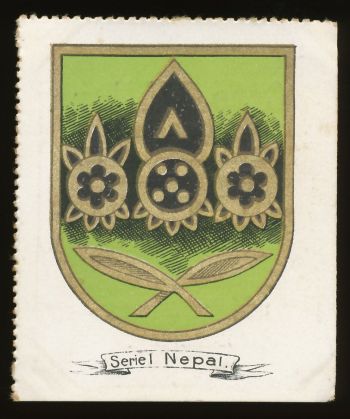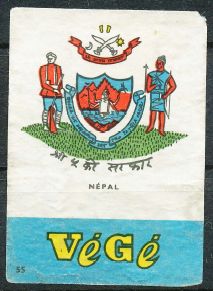National Emblem of Nepal
NATIONAL EMBLEM OF NEPAL
| English | blazon wanted |
Origin/meaning
The emblem of Nepal was adopted on 30 December 2006.
It contains the flag of Nepal, Mount Everest, green hills symbolising the hilly regions of Nepal and yellow colour symbolising the fertile Terai region, male and female hands joining to symbolise gender equality, and a garland of Rhododendron (the national flower). Atop this is a white silhouette in the shape of Nepal.
Previous arms and emblems
The first achievement of the Kingdom of Nepal probably dates from the last years of the reign of King Prithvi Bir Bikram Shah Dev (1881-1911). Probably it is the fruit of a nationalist movement in Nepal from about the turn of the 19th-20th century. At that time almost all princes of some importance on the Indian continent had been granted an achievement by the British Govern-ment.
As it is a device symbolizing the Government of the Kingdom it may also be an invention of Prime Minister Chandra Shumsher Rana (1901-’29). Indeed, the achievement is associated by some authors with the Rana Dynasty.
The achievement can be found on the Prime ministers’seat and on the baldachin above the Prime ministers’seat.
At the turn of the century the arms below were used :
These arms are blazoned:
Arms: The patron deity Sri 108 Pashpatinath in a landscape with the Himalyas in the background all proper.
Crest: Two kukri’s in saltire between a crescent and a sun, the footprints of Sri 108 Gorakhnat in chief and the motto SHRI NEPAL SARKAR (The Illustrious Government of Nepal) on a white scroll in base.
Crown: The Royal Nepalese crown
Supporters: A man of the Guard and a Nepalese huntsman proper
Motto: dulce et decorum est pro patria mori and jananī janmabhūmiśca svargādapi garīyasī (The mother and the motherland are greater than heaven) devanagiri script. In base on a ribbon another motto in devenagiri script.
Below the achievement is the royal cypher of Tribuvana Bir Bikram Shah Dev: TBBS. [4]
The motto in latin means: How sweet and honourable it is to die for the Fatherland, and is from Horatius’ “Odes”, Book III, 2. vs13.
The second motto and the crown were only used by the King, the rest of the arms were used as National Arms.
Another version was used in or around the Second World War, with the soldier in a different uniform.
In 1962 a new national emblem was adopted by Constitution of 16 December 1962.
The new emblem shows between Rhododendron branches the Nepalese plain cut by the river Gandak, on its right bank a white zebu, and on a rock on the sinister a sitting green pheasant (Himalayan Monal, Lophophorus impejanus - Phasianinæ); and a temple and a tree on the dexter and the Himalayas in the distance, all proper. Above the emblem two kukri’s and two national flags in saltire between a crescent and a sun, the footprints of Sri 108 Gorakhnat in chief. Above that the Nepalese crown. Crown: The Royal Nepalese crown.
The supporters and the motto remained.
After the Nepalese Civil War and the restoration of the House of Representatives, the Cabinet replaced the existing national emblem on 15 December 2006. The new emblem was designed by a commission led by Narendra Raj Rajbhandari. On 30 December 2006, the new emblem was introduced.
| The arms as shown on a German collector's card from around 1900 |
The arms on a German matchboxlabel from the 1960s |
Contact and Support
Partners:
Your logo here ?
Contact us
© since 1995, Heraldry of the World, Ralf Hartemink 
Index of the site
Literature : Images and information from Wikipedia and http://rode-leeuw.nl/




